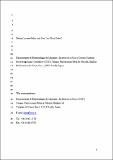Por favor, use este identificador para citar o enlazar a este item:
http://hdl.handle.net/10261/128608COMPARTIR / EXPORTAR:
 SHARE SHARE
 CORE
BASE CORE
BASE
|
|
| Visualizar otros formatos: MARC | Dublin Core | RDF | ORE | MODS | METS | DIDL | DATACITE | |

| Campo DC | Valor | Lengua/Idioma |
|---|---|---|
| dc.contributor.author | Lucena-Padrós, Helena | - |
| dc.contributor.author | Ruiz-Barba, José Luis | - |
| dc.date.accessioned | 2016-02-03T10:00:55Z | - |
| dc.date.available | 2016-02-03T10:00:55Z | - |
| dc.date.issued | 2016 | - |
| dc.identifier | doi: 10.1016/j.fm.2015.09.006 | - |
| dc.identifier | issn: 1095-9998 | - |
| dc.identifier.citation | Food Microbiology 53: 53- 62 (2016) | - |
| dc.identifier.uri | http://hdl.handle.net/10261/128608 | - |
| dc.description.abstract | © 2015 Elsevier Ltd. The presence and enumeration of halophilic and alkaliphilic bacteria in Spanish-style table-olive fermentations was studied. Twenty 10-tonne fermenters at two large manufacturing companies in Spain, previously studied through both culture dependent and independent (PCR-DGGE) methodologies, were selected. Virtually all this microbiota was isolated during the initial fermentation stage. A total of 203 isolates were obtained and identified based on 16S rRNA gene sequences. They belonged to 13 bacterial species, included in 11 genera. It was noticeable the abundance of halophilic and alkaliphilic lactic acid bacteria (HALAB). These HALAB belonged to the three genera of this group: Alkalibacterium, Marinilactibacillus and Halolactibacillus. Ten bacterial species were isolated for the first time from table olive fermentations, including the genera Amphibacillus, Natronobacillus, Catenococcus and Streptohalobacillus. The isolates were genotyped through RAPD and clustered in a dendrogram where 65 distinct strains were identified. Biodiversity indexes found statistically significant differences between both patios regarding genotype richness, diversity and dominance. However, Jaccard similarity index suggested that the halophilic/alkaliphilic microbiota in both patios was more similar than the overall microbiota at the initial fermentation stage. Thus, up to 7 genotypes of 6 different species were shared, suggesting adaptation of some strains to this fermentation stage. Morisita-Horn similarity index indicated a high level of codominance of the same species in both patios. Halophilic and alkaliphilic bacteria, especially HALAB, appeared to be part of the characteristic microbiota at the initial stage of this table-olive fermentation, and they could contribute to the conditioning of the fermenting brines in readiness for growth of common lactic acid bacteria. | - |
| dc.description.sponsorship | This research was funded by the Spanish Ministry of Science and Innovation (MICINN), through Projects AGL2009-07861 and AGL2012-33400, and by the Junta de Andalucía Excellence Projects AGR-04621 and AGR-07345. All these projects included FEDER funds. AMB was the recipient of a post-doctoral grant awarded by the Junta de Andalucía as part of the Project AGR-07345. HLP was the recipient of a contract funded by the Spanish Ministry of Economy and Competitiveness as part of the Project AGL2012-33400. We want to express our most sincere gratitude to Juan Carlos Roldán, from JOLCA S.A., and Antonio Martín and Marta Sánchez, from GOYA en España S.A.U., for their invaluable collaboration in this study. | - |
| dc.publisher | Elsevier | - |
| dc.relation.isversionof | Postprint | - |
| dc.rights | openAccess | en_EN |
| dc.subject | Olive fermentation | - |
| dc.subject | HALAB | - |
| dc.subject | Halophilic bacteria | - |
| dc.subject | Alkaliphilic bacteria | - |
| dc.subject | Biodiversity | - |
| dc.title | Diversity and enumeration of halophilic and alkaliphilic bacteria in Spanish-style green table-olive fermentations | - |
| dc.type | artículo | - |
| dc.identifier.doi | 10.1016/j.fm.2015.09.006 | - |
| dc.embargo.terms | 2017-02-01 | - |
| dc.date.updated | 2016-02-03T10:00:55Z | - |
| dc.description.version | Peer Reviewed | - |
| dc.language.rfc3066 | eng | - |
| dc.rights.license | http://creativecommons.org/licenses/by-nc-nd/4.0/ | - |
| dc.contributor.funder | Junta de Andalucía | - |
| dc.contributor.funder | Ministerio de Ciencia e Innovación (España) | - |
| dc.relation.csic | Sí | - |
| dc.identifier.funder | http://dx.doi.org/10.13039/501100004837 | es_ES |
| dc.identifier.funder | http://dx.doi.org/10.13039/501100011011 | es_ES |
| dc.subject.uri | http://metadata.un.org/sdg/15 | es_ES |
| dc.type.coar | http://purl.org/coar/resource_type/c_6501 | es_ES |
| dc.subject.sdg | Protect, restore and promote sustainable use of terrestrial ecosystems, sustainably manage forests, combat desertification, and halt and reverse land degradation and halt biodiversity loss | es_ES |
| item.fulltext | With Fulltext | - |
| item.openairecristype | http://purl.org/coar/resource_type/c_18cf | - |
| item.cerifentitytype | Publications | - |
| item.grantfulltext | open | - |
| item.openairetype | artículo | - |
| Aparece en las colecciones: | (IG) Artículos | |
Ficheros en este ítem:
| Fichero | Descripción | Tamaño | Formato | |
|---|---|---|---|---|
| Postprint_2016_FoodMic_V54_P53.pdf | 1,97 MB | Adobe PDF |  Visualizar/Abrir |
CORE Recommender
SCOPUSTM
Citations
24
checked on 17-abr-2024
WEB OF SCIENCETM
Citations
22
checked on 24-feb-2024
Page view(s)
279
checked on 23-abr-2024
Download(s)
420
checked on 23-abr-2024
Google ScholarTM
Check
Altmetric
Altmetric
Este item está licenciado bajo una Licencia Creative Commons



